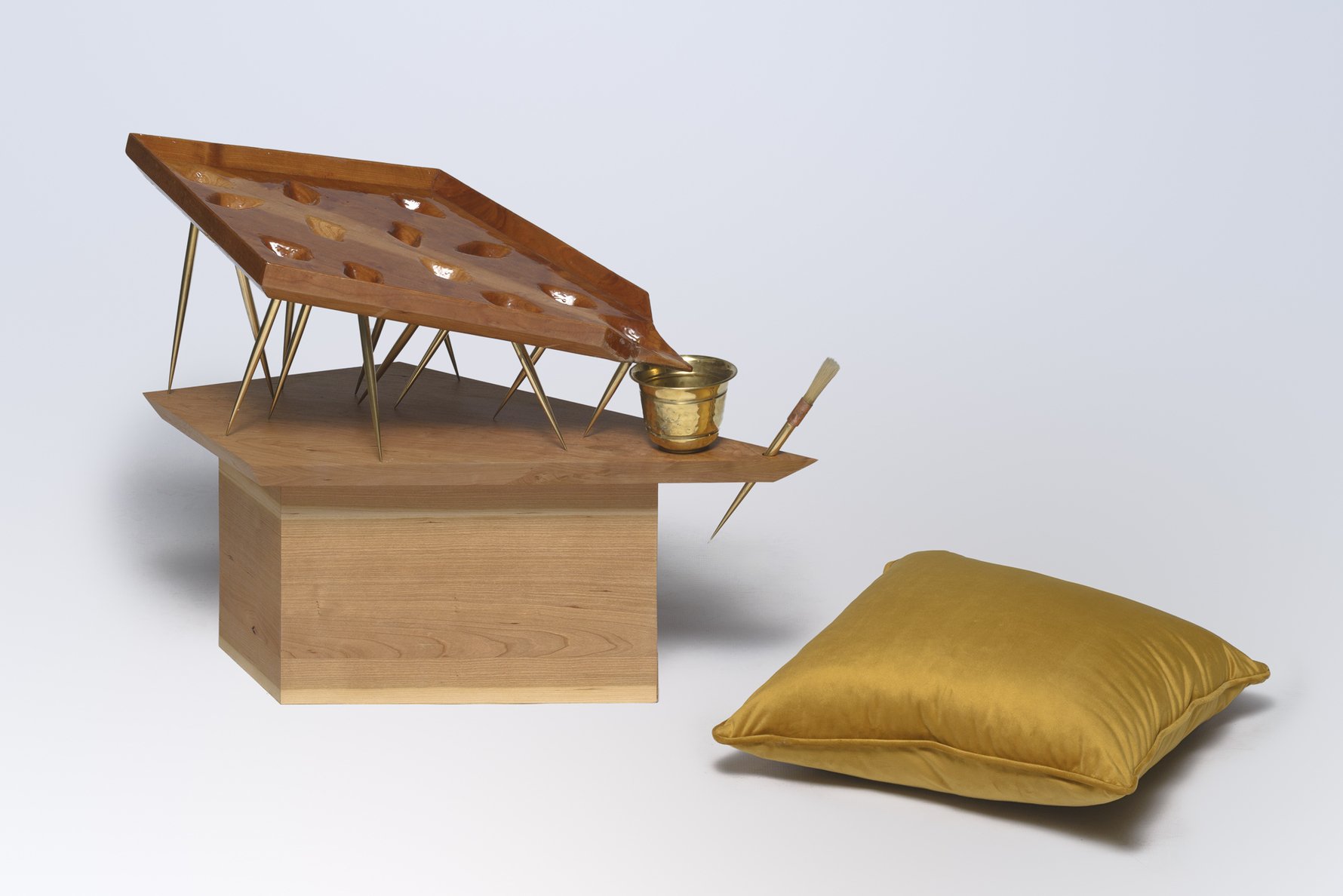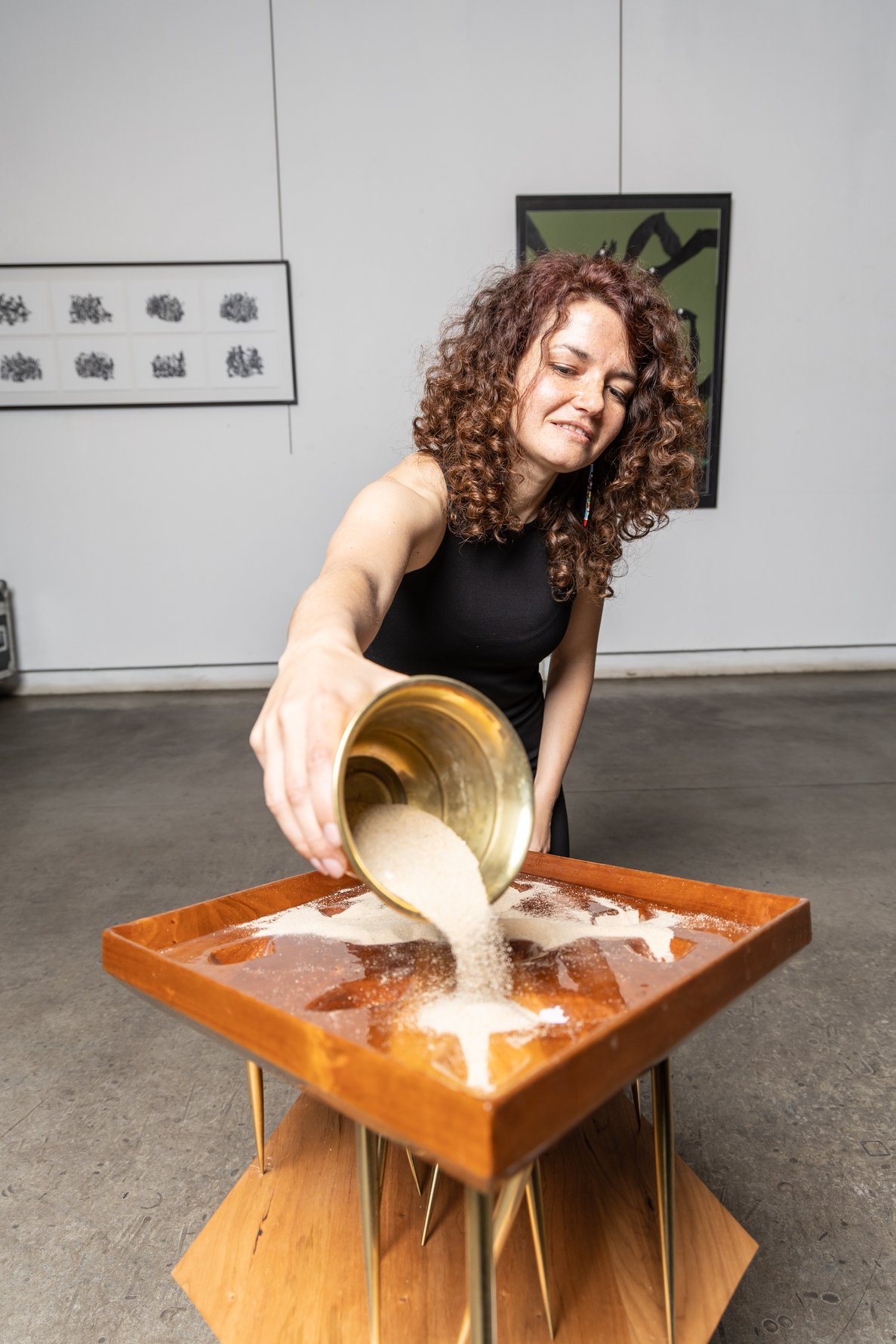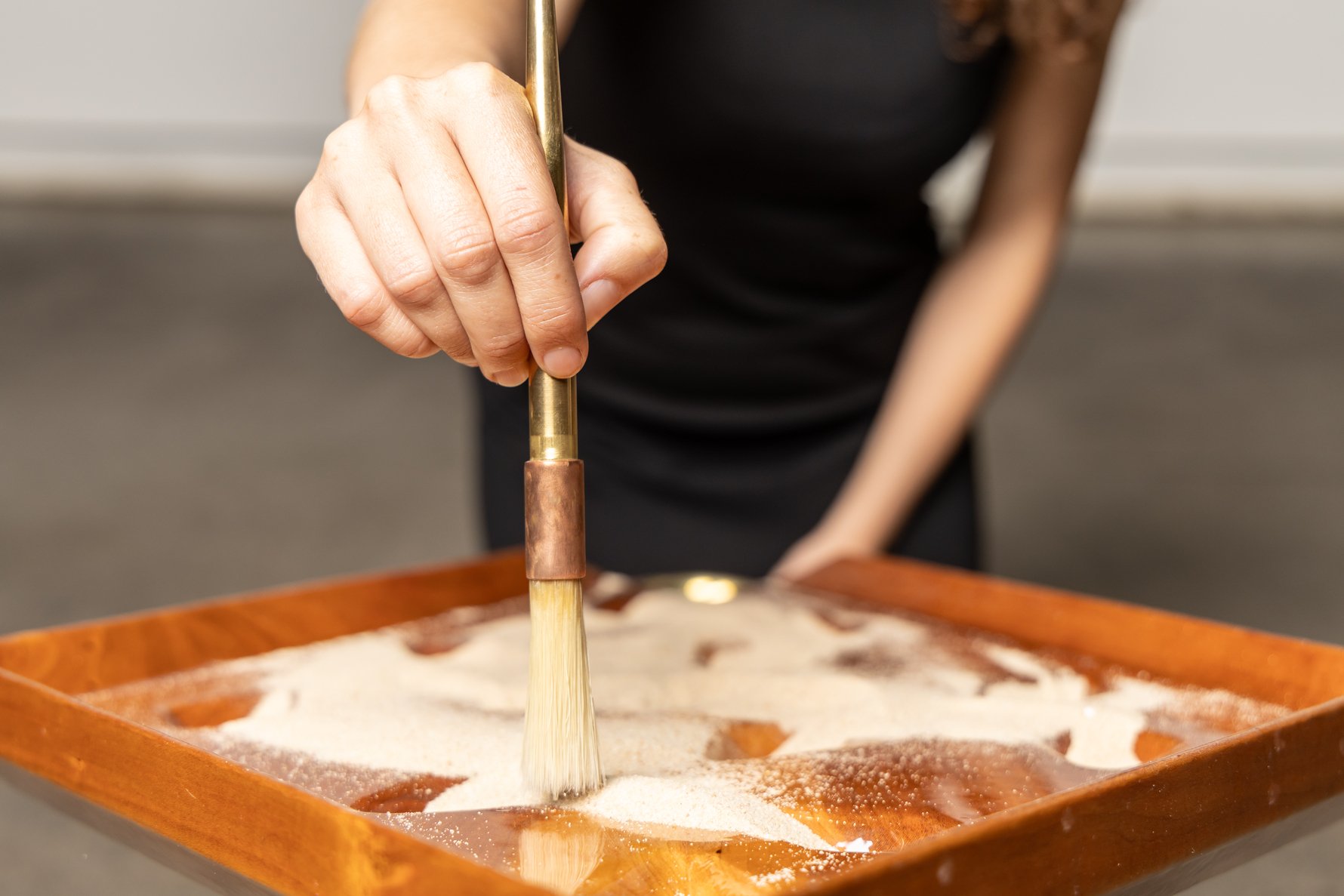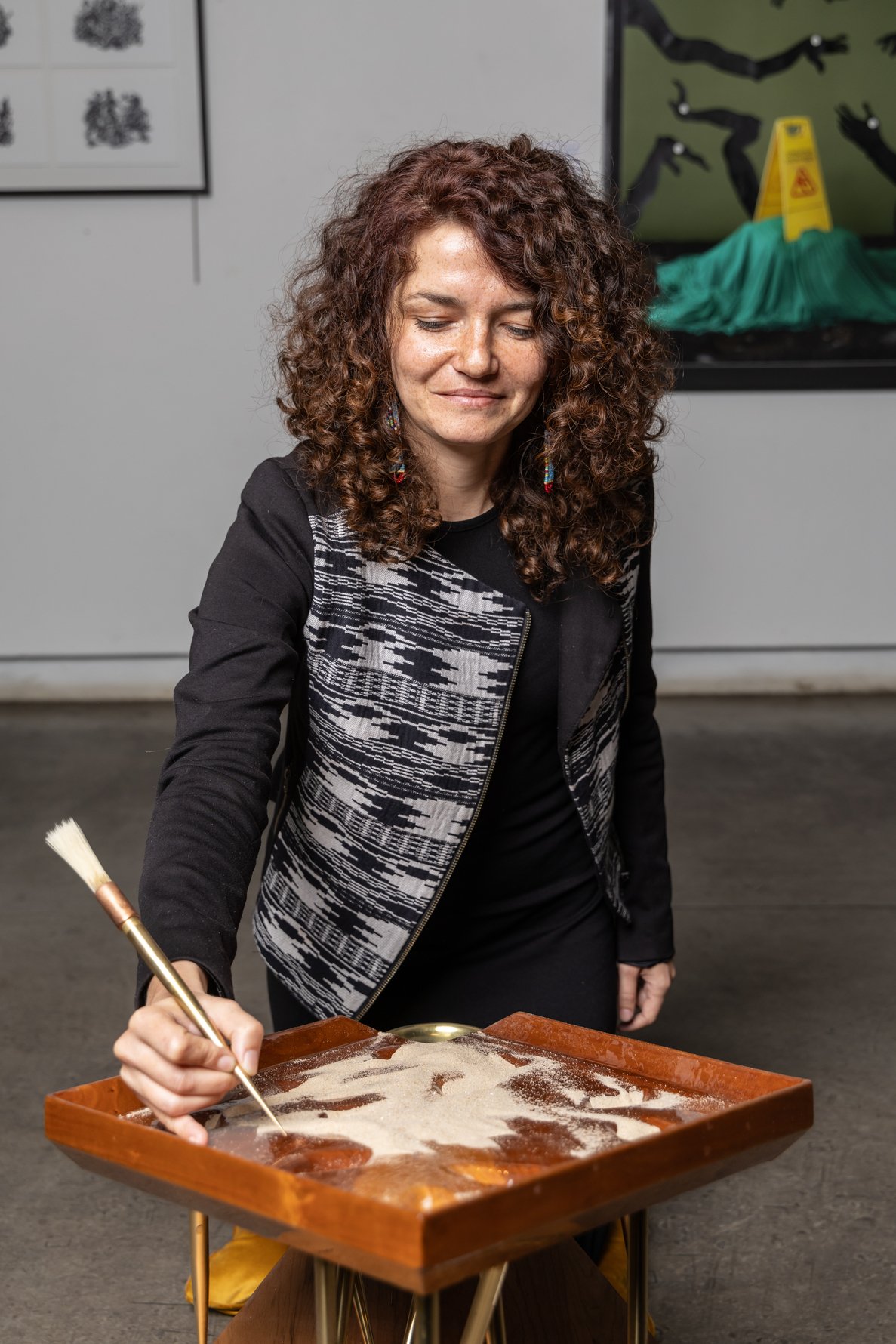"I really enjoy the idea that people can play with my art. Instead of just gazing at the work, you have to allow your entire body to become part of the interaction," says Miné Kleynhans. The overall winner of the prestigious Sasol New Signatures art competition for 2024, her installation piece Meditations on Resentment invites playful (yet no less sincere) engagement from the viewer.
Approaching the artwork, it's initially unclear what is expected of one. Made of solid wood, copper, and brass, the piece looks utterly strange at first glance, like a many-legged creature, though it's not without mysterious beauty. Yet in this unusual work, Kleynhans creates space for an intimate ritual sanctioning the experience and expression of resentment – an emotion often held with secrecy.
Participants are presented with the shiny, indented surface of the work, a brush with a sharpened end, and a bowl of sand. Those who choose to engage in the ritual may kneel in front of the work and pour sand onto the indented surface. Then, the task is to write one's resentment(s) in the sand with the sharp end of the brush before sweeping the sand away and out of the closest cavity until the sharp, hard kernel of a brass thorn is revealed. Rinse and repeat. The scratched words will create a stigmata-like impression of partially revealed resentments on the wooden surface, deepening the piece with time.
As is the nature of installation art, images don't do justice to Meditations on Resentment – it begs to be seen and engaged with in person. Experience Kleynhans' winning work alongside other finalists at the Pretoria Art Museum until Sun, Nov 3, 2024. It's a showcase wonderful in its breadth and diversity.
By day a project manager at University of the Free State Art Gallery and a practising artist, we caught up with Kleynhans about her fascinating art-making and playful plans for a solo exhibition in 2025.

From concept to execution, your Sasol New Signatures winning work is unlike anything we’ve seen from the competition before. How did you present it to the judges in a way that carried the concept across faithfully?
I like to think I chose the correct title and wrote a clear and well-worded artist statement, but that might not be the case at all. Artists often risk over-explaining their concepts. I think I gave the feeling of resentment a great deal of thought – that it is sharp, shiny, and hard, and that it is a pattern of thought that excavates, polishes, and collects. Every part of the artwork suggests something to the viewer. The cushion, for instance, suggests a scene or setting and the participants' bodily relation to the work, even if no one is using it at that moment.
We were very taken with Meditations on Resentment when we saw it at the Pretoria Art Museum. What has the response to it been so far?
For the most part, people seem a little surprised by it, although they seem to enjoy the idea. It is gratifying to me when I see people interact with it or try to understand it better. It does require some explanation because something about the work resonates with them. It is also gratifying when you find that people ‘get it’ and that you have succeeded in making a connection with another person in this way.
"I realised that resentment can be an overpowering current in people’s lives, but that there is also an almost automatic impulse to minimise or hide it from view."

What inspired you to create an artwork about resentment? And what’s worth writing in the sand?
I guess that it started with me being caught up in a situation that was probably rather petty, but it led to a series of discussions with friends and acquaintances. I realised that resentment can be an overpowering current in people’s lives, but there is also an almost automatic impulse to minimise or hide it from view. I was interested in delving into this submerged but very common aspect of our interactions. People have to discover for themselves what they want to write in the sand, I tried not to be prescriptive in that sense.
It’s quite humbling having to kneel to engage with the piece. Why was this important to you?
It’s difficult to articulate, and I don’t think that it is just about humbling yourself, but certainly, that will come up for people. Kneeling is a bodily gesture that puts you in a different frame of mind or relationship to the world. I suppose that it is linked to a religious mind frame as well. Perhaps it is a gesture that invites a receptiveness to something that might be ignored in other circumstances.
Your installation draws users to perform a solitary ritual in a public setting. You’ve described it as “sanctioning resentment”, which could be interpreted as doing penance or being permitted to express taboo feelings more openly. Perhaps it’s a bit of both… tell us more.
‘A bit off both’ is the best interpretation I could hope for. I intentionally tried not to present the work as either too moralistic or therapeutic. I wanted it to remain open and receptive to whatever someone brings to it. That it can be ‘used’ in many different ways. There is also a seductive element to resentment that I tried to convey, and people instinctively sense that it might be dangerous to look at or indulge.

What do you find rewarding about making work that invites physical interaction?
I really enjoy the idea that people can play with my art. It feels like it extends the playfulness of creating the work further to include the viewer more directly. I also think that it asks more of the viewer or audience. Instead of just gazing at the work, you have to allow your entire body to be part of the interaction.
"Some artworks feel like they need to be made so they can develop into something else."
Visually this work is striking too, a cross between a medieval game and a creature from fantasy fiction. What materials did you use, and why?
I like that description. The base and main object are made from cherry wood but with different finishes – epoxy and wax. Cherry wood has a pinkish tone that makes it look slightly fleshy. I used brass for the spikes and other details because of its shiny, hard quality and because it is attractive and inviting.
What makes Meditations on Resentment different from anything you’ve created before?
I can see how it developed from other work I’ve made and other materials that I’ve been using. It feels like it might be one of the most ‘complete’ artworks I have made so far in that all its aspects feel resolved. Some artworks feel like they need to be made so they can develop into something else.

A giant in the local art world, you’ve had Willem Boshoff as your co-supervisor. What has working with him taught you?
I think that the way in which Willem’s life is entrenched in his work, or perhaps it is the other way around, has made a big impression on me. Willem’s mind is always observing and making connections in a very specific way. His artworks are just one byproduct of the vast sea of knowledge he has accumulated and archived.
Part of your prize as the overall winner means a solo exhibition next year. It’s early days, but what’s turning over in your mind around this?
I have initiated one or two things in the studio and can see a vague, underlying theme emerging. I hope I can make people more self-reflective artworks to play with. I am excited at the prospect.
"My approach to art is to create work that asks people to ‘play-pretend’ with me but then also to consider how we move or act in the world from a different angle."
How would you describe your philosophy as an artist or your approach to art?
Perhaps I should only answer that question a year from now. I want to create art because it imbues the world with a sense of mystery and meaning, but there is also an element of ‘play-pretend’ in that. My approach to art is to create work that asks people to ‘play-pretend’ with me but then also to consider how we move or act in the world from a different angle.

What are your reflections on the Sasol New Signatures art competition, more broadly, as a springboard for South African artists?
I think the Sasol New Signatures art competition is doing incredibly important work as it levels the playing field and provides artists with more equal opportunities. Artists from diverse backgrounds and all walks of life, with and without formal training, can submit their work to be considered by the art world and the general public. It grants entry into a sector notoriously hard to find a foothold in.
One hundred and thirty seven works made it to the 2024 showcase at the Pretoria Art Museum. Tell us about a few that stood out to you.
I think that it was a really strong selection and I feel very honoured to have even made it to the top seven finalists, all of whom made very deserving artworks. From these, I especially appreciate the sincerity and vulnerability that Tandabantu Nathaniel Jongikhaya Matola managed to convey in his work, as well as the ingenuity of Juandré van Eck’s piece – another interactive artwork.
Read more about the merit award winners and runners-up of the 2024 Sasol New Signatures art competition here.
One hundred and thirty seven works by artists across South Africa made it to the annual finalists' exhibition at Pretoria Art Museum, showing until Sun, Nov 3, 2024. Alongside, 2023 Sasol New Signatures winner Nosiviwe Matikinca holds her first solo exhibition, Ukungalingani Kwezemfundo (Educational Inequality).


_m.jpg)
_m.jpg)
-1_m.jpg)


Comments